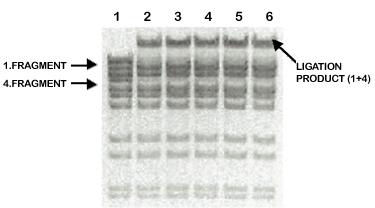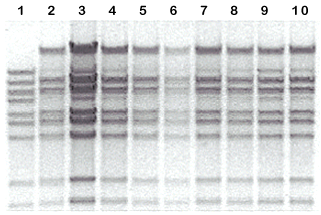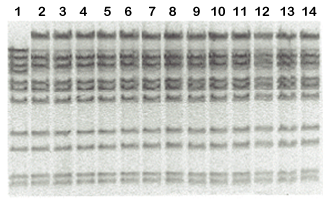Application
- Ligase Chain Reaction (LCR)
- Oligonucleotide Ligation Assay (OLA)
- Mutagenesis by Incorporation of a phosphorylated oligo during PCR Amplification
- Simultaneous Mutagenesis of Multiple Sites
Supplied with Enzyme
- 10 x Reaction Buffer (1 ml): 300 mM Tris-HCl (pH8.3), 250 mM KCl, 50 mM MgCl2, 5 mM NAD
- 1 x Dilution Buffer (1 ml): 10 mM Tris-HCl (pH7.6), 0.1 mM EDTA, 50 mM KCl, 1 mM DTT, 200 ug/mL acetylated BSA,
50% Glycerol
Storage Condition
20 mM Tris-HCl (pH7.6), 2 mM MgCl2, 1 mM EDTA, 1 mM DTT, 0.5% Tween -20, 0.5% IGEPAL CA-630, 50% Glycerol, store at -20°C.
Concentration
20 units/μl
Unit definition
One unit of Tfi DNA Ligase is defined as the amount of enzyme required to give 50% ligation of the 12 base pair cohesive ends of 1 ug of PspEI digested lambda DNA in 10min at 45°C.
Activity Assay Conditions
The activity assay is carried out in a 20 μl reaction containing 1 ug of PspEI digested lambda DNA and 1 x Tfi DNA ligase reaction buffer. After incubation at 45°C for 10 min., the reaction is terminated by addition of stop solution (40%(w/v) sucrose, 50 mM EDTA and 0.25% bromophenol blue). Then heat at 70°C for 10 min and immediately load on a 0.8% agarose gel.
Stability
The half-life of the enzyme in 1 x reaction buffer is more than 1 hour at 95°C and 55 hours at 65°C.
Note
Tfi DNA Ligase should not be used as a substitute for other DNA ligase, i.e., T4 DNA Ligase.
References
1. Barany, F. (1991) Proc. Natl. Acad. Sci. USA, 88, 189 - 193.
2. Landegren, U. et al.(1988) Science 241, 1077 - 1080
3. Michael, Scott F. (1994) Biotechniques 16:3, 410 - 412.
4.Gerard J. A. et al. (1993) Biotechniques 15:1, 172 - 178.
Experimental Data
Fig 1. Ligation test at various temperatures (45°C~ 65°C)

Incubate the reaction containing ligase 1 unit and 1 ug DNA[lambda PspEI] at each temperature for 10 min.
Lane 1: λ DNA/PspE I (control) Lane 2: Incubate at 45°C, 10 min
Lane 3: Incubate at 50°C, 10 min Lane 4: Incubate at 55°C, 10 min
Lane 5: Incubate at 60°C, 10 min Lane 6: Incubate at 65°C, 10 min
Fig 2. Heat Stability test at 95°C

Incubate the enzyme at 95°C each time. And then add 1 unit ligase to a 20 ul reaction containing 1ug DNA[lambda PspEI] and incubate the mixture at 45°C for 10 min.
Lane 1: λ DNA/PspE I (control) Lane 2: Incubate at 95°C, 10 min
Lane 3: Incubate at 95°C, 20 min Lane 4: Incubate at 95°C, 30 min
Lane 5: Incubate at 95°C, 40 min Lane 6: Incubate at 95°C, 50 min
Lane 7: Incubate at 95°C, 60 min Lane 8: Incubate at 95°C, 70 min
Lane 9: Incubate at 95°C, 80 min Lane 9: Incubate at 95°C, 90 min
Fig 3. Heat Stability test at 65°C

Incubate the enzyme for each time at 65°C and then add 1 unit ligase to a 20 ul reaction containing 1 ug DNA[lambda PspEI] and incubate the mixture at 4°C for 10 min.
Lane 1: λ DNA/PspE I (control) Lane 2: Incubate at 65°C, 6 hrs
Lane 3: Incubate at 65°C, 12 hrs Lane 4: Incubate at 65°C, 18 hrs
Lane 5: Incubate at 65°C, 24 hrs Lane 6: Incubate at 65°C, 30 hrs
Lane 7: Incubate at 65°C, 36 hrs Lane 8: Incubate at 65°C, 42 hrs
Lane 9: Incubate at 65°C, 48 hrs Lane 10: Incubate at 65°C, 54 hrs
Lane 11: Incubate at 65°C, 60 hrs Lane 12: Incubate at 65°C, 66 hrs
Lane 13: Incubate at 65°C, 72 hrs Lane 14:Incubate at 65°C, 78 hrs